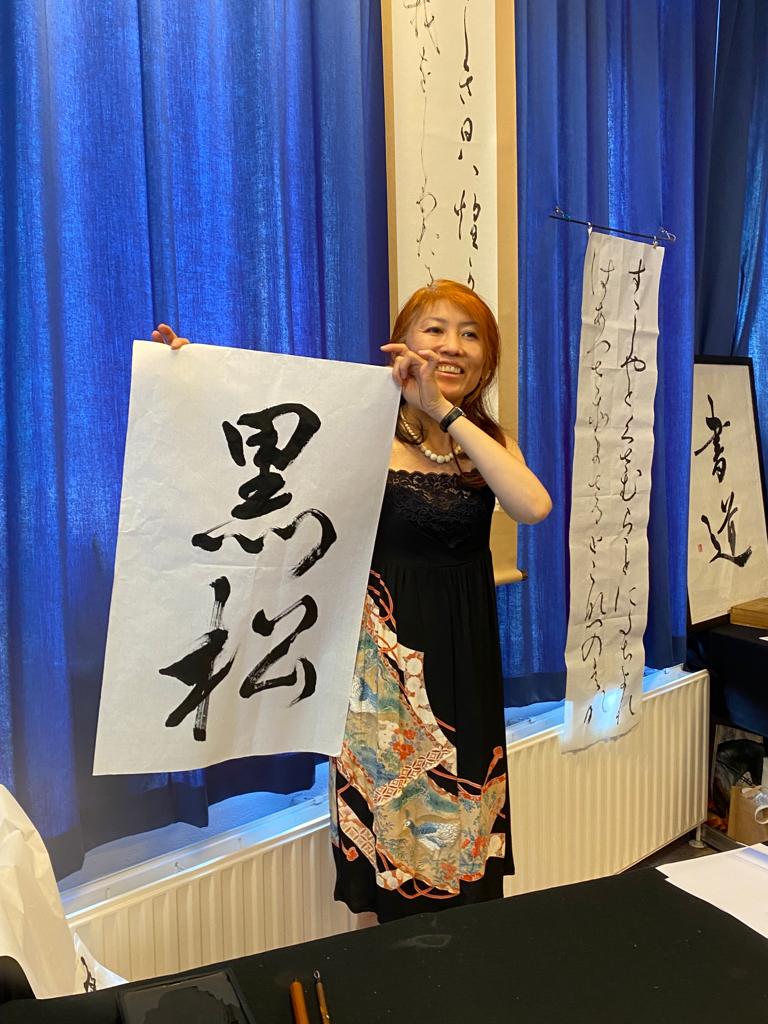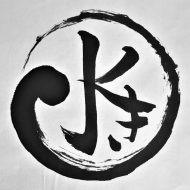I demonstrated Calligraphy ( shodo) at the Bonsai Club Noord bonsai exhibition in Groningen-Haren, 24-25 June.
Thank you to all those who came to see, organisers and other participants
Because my husband is also a member of this club, I got this request of demonstration, it was 2 weeks before.
I was a little worried because 2 weeks was too short a time for prepare, but as it was an opportunity to introduce calligraphy in my home town, I took it on.
Tropical weather is becoming the norm in the Dutch summer. And it was true summer day on both days!
The request for a kimono was rejected and I wore a ‘kimono remake dress’. Even so, I sweated enough (laughs).
Besides bonsai …
At the place , there were many beautiful bonsai displays by club members, demonstrations by famous Bonsai- master Mr. Bruno Wijman, bonsai goods and accessories of Chinese origin, paintings in Japanese style, pots and accessories by potters, etc.

Outside, Syrian immigrants sell snacks. Fried minced meat, spinach in wraps, grilled cheese, etc. The nutcake was delicious and full of honey.
Calligraphy was also given a seat as part of the varied program of events.
Rinsho and jiun
At the Nienord Art Market in October 2022, I gave a demonstration of ‘Rinsho(臨書)’ on half-sheet paper (approx. 130 cm x 37 cm) with kana and semi-cursive style of Kanji. Rinsho is a process of a reproducing a manuscript as faithfully as possible, while digesting it and finding it’s a ‘ smell’ within oneself.
There were so many ‘firsts’ for me – exhibiting artworks, selling goods and demonstrating calligraphy – that after much deliberation, therefore I decided to demonstrate my usual calligraphy practices.
While ‘Rinsho’ is educational and interesting for calligraphers, but it seems to be plain and boring for those who don’t know calligraphy.
Based on the experience of the previous demonstration, I was a little more conscious of ‘showing’ and performed ‘Jiun(自運)’ for the first time in my life, in addition to ‘Rinsho’.
Jiun(自運)meants to the free expression of one’s own writing without following a model. Although ‘free’, the characters are someone else’s creation, and there are predecessors who have established it as ‘calligraphy’. It is a creation based on their will.
“Free” but not “cheap”…
I was nervous because I have never shown even my students in the classroom how I do the ‘Jiun’ (laughs).
characters associated with bonsai
The characters I wrote were the names of plants related to bonsai. Black pine(黒松), bonsai(盆栽), summer camellia(夏椿)…
When I looked up the names of the plants again, I felt the connection between the kanji characters, their meanings and the thoughts of the people who named them.
Heian grass-Kana
For my Rinsho(臨書), I chose one Tanka(短歌) from the Wakan rou ei shu(和漢朗詠集)(Japanese-Chinese poetry anthology), which is unknown to the poet.
Su zu shi ya to ku sa mu ra go to ni ta chi yo re ba a tsu sa zo ma sa ru to ko na tsu no ha na
~I stopped at every grassy knoll to see if it was cooler, but everywhere there were everlasting summer flowers and it got even hotter.~
It’s not an interesting poem, but I thought it was summery.
I looked up the meaning and found that it is a love letter-like poem with a ‘meaning behind the meaning’ peculiar to the Heian period (laughs).
‘Drop in’ has the meaning of ‘a man visiting a woman’.
The ‘toko’ in ‘Toko natsu (everlasting summer) ‘ is the same sound as ‘toko = a bed’. It is a ‘play on words…
I thought it would be cooler, but it’s extra hot…
I got it
Entertainer’s mind? (^^)
In the demonstration, I was conscious of ‘showing’, so it was difficult to concentrate at first. I was in a light dilemma because I don’t usually do calligraphy for the purpose of showing it to others.
I was careful not to make my brush strokes sound fake, but as the sessions went on I got the hang of it and the organizers told me that I was getting better and better every time.
Then, unexpectedly, I remembered when I started singing at the bar. At first no one listened to me, but as I got more creative, people started to come…
And I was reminded that I still love entertainment.
. I didn’t think I’d ever get to do that with calligraphy.
Bonsai and Shodo
Bonsai is said to be the process of transforming the branches, leaves, trunks, etc. of living plants into a form that one considers beautiful.
What’s the point of doing that when the plant itself is already beautiful? I used to not understand it well and even thought it was painful to see it wired up.
But as my husband works hard and carefully to wire, cut and care for the branches, the plants become more and more beautiful and vigorous.
‘So the plants are happy too…’ Then I started to think bonsai was wonderful.
You’ll never write the same character in a calligraphy.
Bonsai also never grow the same branches and leaves.
And in conversation with what we face.
Cutting through ‘the moment’.
change
It’s the same with everything called ‘art’…
I got annother interesting experience.

The whole event was well received by the students, friends, family and acquaintances who came to see it.
Some people won a raffle and went home with bonsai trees, props and other items.
I was happy that people didn’t regret coming despite the hot weather♪
The next project is on 7 and 8 October.
I will give demonstration in Nienoord art market.
I have a plan with something new.
stay tuned♪

